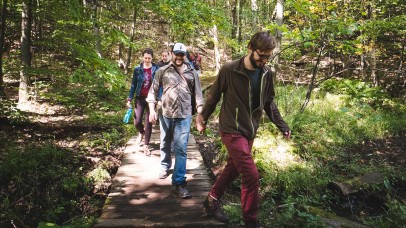Most McGillians seeking an escape from the city ascend the stairs of Mount Royal or roam the winding concrete paths at Jean Drapeau Park. However, those looking for an authentic adventure in the wilderness should venture out to McGill’s Gault Nature Reserve, a 1000-hectare property owned by the university. Though often unexplored by students, the 60-year-old reserve is situated on Mont St. Hilaire and hosts a variety of athletic and educational activities that are open to the public year-round.
Test out the hiking trails
Students looking to enjoy the quiet countryside can amble along Gault’s secluded pedestrian paths during their visit. On autumn hikes throughout the property, visitors can take in sweeping vistas, local wildlife, and the changing foliage. Gault maintains eight trails of varying intensities which are accessible to the visitors 365 days a year. The trails span across 25 kilometres of forest and allow walkers to navigate their way along Lac Hertel and up the rocky Mont St. Hilaire hillsides. Though novices may find some of the trails challenging, staff is available at the visitor pavilion to advise hikers on their itineraries.
Snowshoeing
Once snow falls, outdoor enthusiasts are welcome to snowshoe across the reserve. The activity is difficult to attempt in an urban setting in which snow is regularly shoveled, but the reserve’s peaceful rural trails make this the ideal place to try the sport. Students can rent snowshoes from the university for 13 dollars, and, other equipment, such as snow poles, is also available. Though guests are only permitted to snowshoe on specified trails, the snow is fresh, and there is little foot traffic.
Observe research in action
Founded with the dual mission to provide public outdoor space and an open-air research facility to McGill students, Gault is home to a variety of scientific projects that visitors can observe around the property. Current field projects include Assistant Professor Virginie Millien’s investigation on the relationship between genetic mutations in mice and climate change. Also on site is Professor Andrew Gonzalez’s Large Experimental Array of Ponds (LEAP) project, featuring artificially-constructed aquatic communities used to study the impact of environmental stressors on freshwater ecosystems. Other smaller fieldwork projects also regularly take place on the grounds, and, if they are lucky, guests can witness scientific history in the making.
Learn about the local ecosystem
As an outdoor classroom, the bucolic reserve offers several opportunities to learn more about Montreal’s flora and fauna. In 1978, Gault was the first Biosphere in Canada given special status under the UNESCO’s Man and the Biosphere Program for its diverse ecological community. Today, the reserve is home to a diverse selection of fish, plants, and reptiles. Partnered with the Société d’ornithologie de la Vallée du Richelieu (SOVDR) bird-watching group, researchers have identified an impressive 200 species on the reserve. For students interested in learning more about the natural populations at Gault, the reserve also hosts lecture events throughout the academic year.
From downtown Montreal, students can access the Gault Nature Reserve via the 11 bus to Mont-Saint-Hillaire and the Ligne Mont-Saint-Hilaire, which departs from Montreal Central Station.









